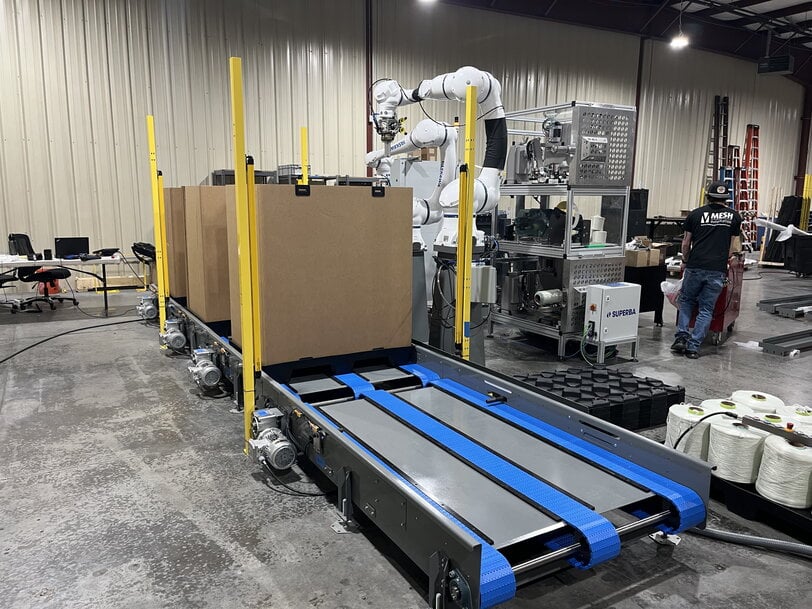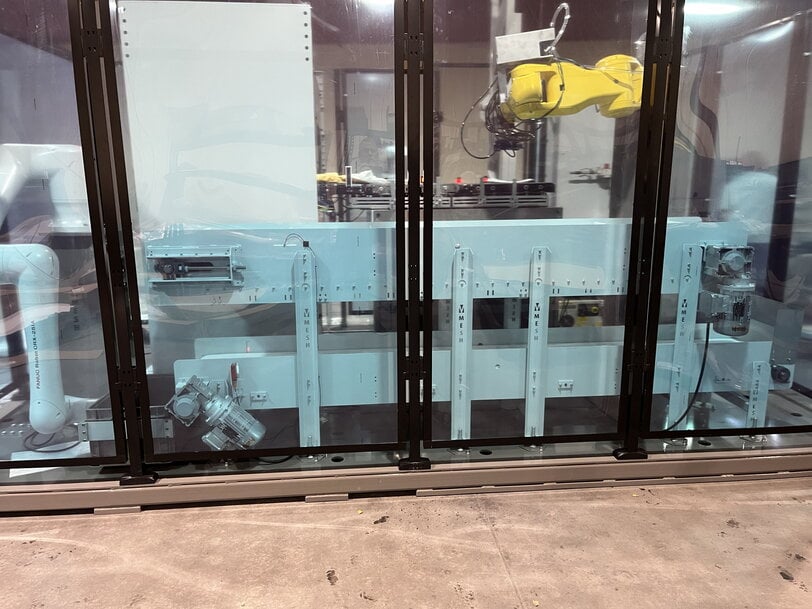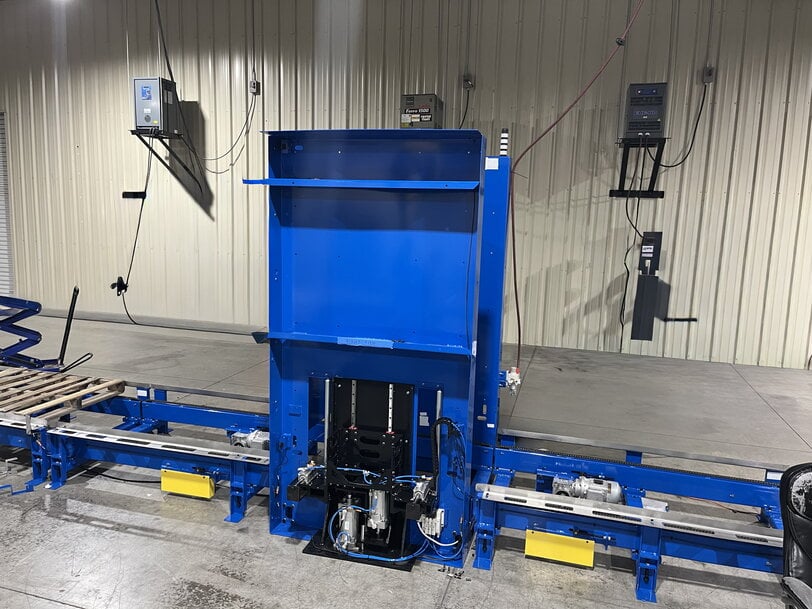www.magazine-industry-usa.com
14
'25
Written on Modified on
NORD DRIVESYSTEMS Powers Automation Success at MESH
Discover how MESH Automation leverages high-quality gear motors from NORD DRIVESYSTEMS to deliver robust, reliable automation solutions across diverse industries.
www.nord.com

Consider the following scenario: guided by vision sensors, a robot spots a product on a moving conveyor, determines its exact position and, in one fluid motion, picks it up and places it into a waiting assembly, carrier tray, or shipping container. What human operators once found tiring—or at least tedious—the robot performs flawlessly, hour after hour, even long after its flesh-and-blood coworkers have gone home for the evening.
Given the ongoing shortage of skilled workers, we can expect to see many more such scenarios, especially as the U.S. ramps up its reshoring efforts. That's where John London, Director of Operations at MESH Automation, comes in. "Getting parts and products positioned precisely without fail—there's little room for error," he says. “That’s long been one of the primary challenges with many competing automation systems. But not for us.”
Since its founding in 1999, MESH Automation of Dawsonville, Georgia, has been meeting these and other automation challenges head-on. The company designs and builds robotic palletizing, machine tending, material handling, and warehouse control systems for an eclectic mix of customers across practically every industrial manufacturing sector.
Whether they’re building solutions for automakers and their tier suppliers or food processors, roofing material producers, fertilizer manufacturers and many others, MESH and its 40+ employees work to provide robust and reliable automation systems by focusing on craftsmanship, attention to detail, and commitment to excellence.
Proud Partnerships
Part of this success stems from strategic partnerships with some of the leading names in automation. These include FANUC, Siemens, and Cognex, to name a few, all of which contribute to MESH Automation's reputation for quality and dependability. But with automation comes the equally important need to bring products and materials to and from the machine tool, packing station, or inspection system, and do so without fail.
For this critical task, MESH depends on a supplier with equivalent recognition throughout the industry: NORD DRIVESYSTEMS. “I like to tell people that, even though we build conveyors, we're not a conveyor company,” says London. “Still, we make a lot of them, and pretty much all are located within 30 feet or so of a robot.”
For the past three years, he adds, each of these conveyors has used NORD helical worm gear motors to move whatever’s sitting on top of it.
This particular partnership began thanks to a COVID-induced supply chain disruption; after MESH Automation’s previous gearmotor supplier ran into inventory problems, London and his team reached out to their distributor, Motion Automation Intelligence of Birmingham. The sales representative there suggested they give NORD a try. Unfortunately, the very first shipment hit a snag—the motors arrived damaged in transit.
"That's when I knew NORD would be a good company to work with," London says. “Their standard lead time was six weeks at the time, but they were able to deliver replacement motors in just two, keeping us on schedule. That told me a lot about their emphasis on customer service.”
This support level continues to this day. In one recent example, a MESH apprentice accidentally wired three motors incorrectly, causing them to burn out during startup. After being notified of the situation, NORD's Charlotte plant prepared replacements within a few hours, allowing a MESH project manager to pick them up that afternoon. "That was a big deal for us, and it reinforced what I already knew: NORD DRIVESYSTEMS is a solid company, as is our relationship with them," London says.

Diverse Needs
The partnership with NORD has served them well. As noted earlier, MESH enjoys a diverse customer base, with no industry segment exceeding 25% of its business. “We don't want just one industry feeding us," London explains. "Despite their differing needs, however, we're able to cost-effectively deliver automated systems to each of these industries due to our use of pre-engineered platforms, which we can easily modify for specific applications.” He laughs. “No two are identical, although we do use terms around here like 'half identical’ and ‘three-quarters identical’ to describe the level of customization needed to meet customer requirements.”
NORD helps in this respect as well. For instance, MESH technicians can quickly change the gear ratio on any motor, a normally onerous chore made possible by NORD's modular, interchangeable components. This flexibility allows them to easily adjust the speed and torque to match the application without having to stock additional components. And when a special order is called for, notes London, "They've pretty much had whatever we need in stock or available within a couple of weeks."
Whatever the customization level, these platforms often fall under the “MAC” family of automation cells—the MACTend for machine tending, the MACPac for packaging tasks, the MACGrind for finishing small- to medium-sized parts, and so on. Together with its assortment of process-specific “bolt-on” modules, each offers a starting point for MESH engineers to design what are effectively custom solutions but without the associated price point.
Prove It
Among the many customer success stories posted on the company website is a manufacturer of carpet tiles, which needed to feed "master" tiles to a press that cuts them into smaller pieces, a step known as "planking." Here, MESH delivered a cell containing a pair of vision-equipped robots and custom end-of-arm tooling able to replicate the delicate but ergonomically taxing motions of a human operator.
In another, a company that constructs hurricane-proof sheds wanted an automated way to screw the wall and roof panels to the wooden frame. In the past, this operation proved both labor-intensive and error-prone. Yet MESH designed a system with two robots, each armed with a screw gun to fasten the panels, following pre-programmed paths and working around window and door openings while ensuring consistent attachment quality.
And a company supplying machined components to its automotive customer desired to augment its human workforce by going “lights out” for three days at a time. This endeavor wouldn't be notable except for the fact that two different castings were used to produce six different part numbers, which meant that the system had to be "smart" enough to identify each workpiece before loading it into the CNC lathe. MESH accommodated this requirement by integrating a vision inspection system into the cell, reading each casting number and tracking it both during and after machining.
Each of these solutions and many others share a common theme: the need for dependable conveyors to move products, parts, and materials into and out of the cell. Without them, nothing happens, which is why the company continues to rely on NORD products, despite their being a bit more expensive than those of the previous supplier.
Says London, “We buy around seventy NORD gear motors each year and are actually paying slightly more than we did before, but the partnership we've built is well worth the extra money. We’re not one to beat someone up on price and then run away when there's an issue—instead, we place great value on suppliers who offer a fair price and stand behind their products. That’s what NORD does.”
Fast Movers
MESH's latest project may be its most ambitious yet: a robotic induction system for e-commerce sortation, which debuted at the recent ProMat 2025 trade show. The system uses a vision-guided robot to pick items from bins, scan barcodes on either side of the box, package, or envelope, and place each on a high-speed conveyor feeding a bomb bay-style sorter. Here again, the system depends on NORD worm gear motors to keep everything moving.
London notes that the scanning capability eliminates a key limitation of current systems, where operators must place items with barcodes facing upward. “Our system doesn't care which way the label faces. It also picks 1,800 items per hour—well beyond what a human operator can achieve. We think it’s the first such solution on the market.”
When asked a question that’s at the top of mind for many—whether automation is putting people out of work—London pushes back. “Our robotic cells don't replace people—they move them to better jobs. For example, I’ve seen how the companies that implement automation can often expand their quality control efforts. They put more energy into making sure products meet higher standards. And because workers no longer have to perform the repetitive, oftentimes strenuous tasks common in manufacturing, they’re able to spend more time on process improvement, oversight, and other value-added activities. It's better for everyone involved and makes the company more profitable to boot. That's what automation delivers.”


